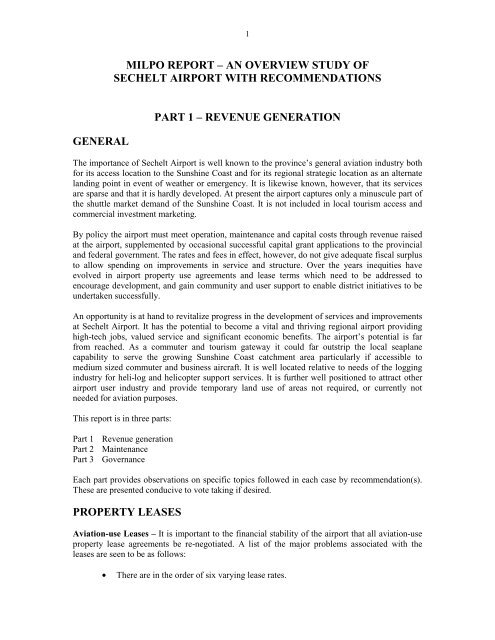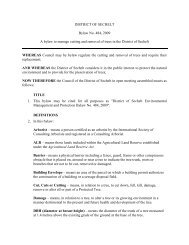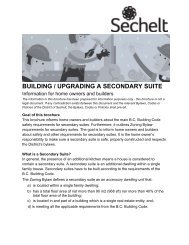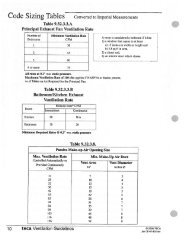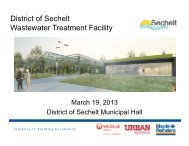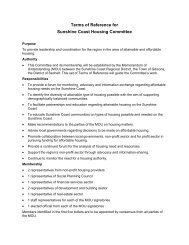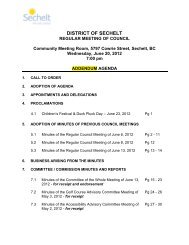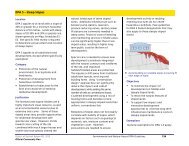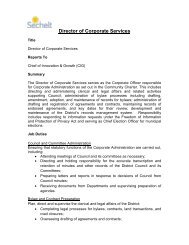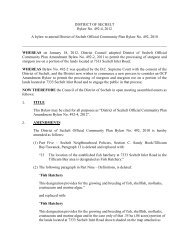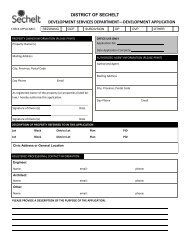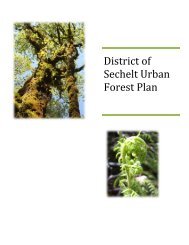study (PDF format, 68kb) - District of Sechelt
study (PDF format, 68kb) - District of Sechelt
study (PDF format, 68kb) - District of Sechelt
You also want an ePaper? Increase the reach of your titles
YUMPU automatically turns print PDFs into web optimized ePapers that Google loves.
GENERAL<br />
1<br />
MILPO REPORT – AN OVERVIEW STUDY OF<br />
SECHELT AIRPORT WITH RECOMMENDATIONS<br />
PART 1 – REVENUE GENERATION<br />
The importance <strong>of</strong> <strong>Sechelt</strong> Airport is well known to the province’s general aviation industry both<br />
for its access location to the Sunshine Coast and for its regional strategic location as an alternate<br />
landing point in event <strong>of</strong> weather or emergency. It is likewise known, however, that its services<br />
are sparse and that it is hardly developed. At present the airport captures only a minuscule part <strong>of</strong><br />
the shuttle market demand <strong>of</strong> the Sunshine Coast. It is not included in local tourism access and<br />
commercial investment marketing.<br />
By policy the airport must meet operation, maintenance and capital costs through revenue raised<br />
at the airport, supplemented by occasional successful capital grant applications to the provincial<br />
and federal government. The rates and fees in effect, however, do not give adequate fiscal surplus<br />
to allow spending on improvements in service and structure. Over the years inequities have<br />
evolved in airport property use agreements and lease terms which need to be addressed to<br />
encourage development, and gain community and user support to enable district initiatives to be<br />
undertaken successfully.<br />
An opportunity is at hand to revitalize progress in the development <strong>of</strong> services and improvements<br />
at <strong>Sechelt</strong> Airport. It has the potential to become a vital and thriving regional airport providing<br />
high-tech jobs, valued service and significant economic benefits. The airport’s potential is far<br />
from reached. As a commuter and tourism gateway it could far outstrip the local seaplane<br />
capability to serve the growing Sunshine Coast catchment area particularly if accessible to<br />
medium sized commuter and business aircraft. It is well located relative to needs <strong>of</strong> the logging<br />
industry for heli-log and helicopter support services. It is further well positioned to attract other<br />
airport user industry and provide temporary land use <strong>of</strong> areas not required, or currently not<br />
needed for aviation purposes.<br />
This report is in three parts:<br />
Part 1 Revenue generation<br />
Part 2 Maintenance<br />
Part 3 Governance<br />
Each part provides observations on specific topics followed in each case by recommendation(s).<br />
These are presented conducive to vote taking if desired.<br />
PROPERTY LEASES<br />
Aviation-use Leases – It is important to the financial stability <strong>of</strong> the airport that all aviation-use<br />
property lease agreements be re-negotiated. A list <strong>of</strong> the major problems associated with the<br />
leases are seen to be as follows:<br />
• There are in the order <strong>of</strong> six varying lease rates.
2<br />
• Inequities are evident in lease assessment policy, i.e. the two commercial helicopter<br />
leases account for over half the total airport revenue. Non commercial aircraft owners<br />
account for the majority <strong>of</strong> airport use yet its two representative organizations, the<br />
Elphinstone Aero Club and the Recreational Aircraft Association are assessed a token<br />
one dollar annual fee each for the largest tracts <strong>of</strong> property under lease.<br />
• There is no established building setback and parking area policy for lease properties.<br />
• Lease income potential is depressed and good land use overlooked through the<br />
practise <strong>of</strong> allowing single bay hangars on small lots.<br />
• A joint charter airservice and flight school do not operate from a lease property but<br />
from a small, overcrowded rental trailer, owned and insured by the district, at a fee <strong>of</strong><br />
$150 per month.<br />
• The major disadvantage to airport investment and, in fact, to both parties in the Lease<br />
Agreements is the short length <strong>of</strong> term which makes it difficult to secure financing.<br />
This is further exasperated by the disadvantages evident in the lease that all but<br />
prevents a lessee from recovering the value <strong>of</strong> leasehold improvements either through<br />
resale or ongoing consecutive lease extensions once the lease term is complete.<br />
Re-negotiation <strong>of</strong> aviation-use property leases would likely be well received by most current<br />
lessees if lease inequities were eliminated, and all lessees subject to a standard commercial<br />
(serviced) lease rate or a lesser non-commercial (unserviced except for sprinklers) lease rate with<br />
a maximum initial term <strong>of</strong> twenty (20) years at the end <strong>of</strong> which the lessee could qualify for<br />
ongoing five year terms subject to certain upkeep and esthetic improvements that might be<br />
required by <strong>District</strong> Council. Lease rates should be established in comparison to other airports<br />
and not local industrial park rates. A one-industry facility should reflect favourable rates<br />
attractive to a narrow market.<br />
RECOMMENDATION<br />
That all current property leases and agreements for aviation purposes be renegotiated with<br />
the aim <strong>of</strong> their replacement by a new common lease that differs only in length <strong>of</strong> term, size<br />
<strong>of</strong> lease area and specified use <strong>of</strong> lease area.<br />
That the maximum length <strong>of</strong> lease term be established at twenty (20) years plus a five year<br />
option to renew and allow lessees to apply to <strong>District</strong> Council for each five year renewal<br />
following completion <strong>of</strong> the twenty-five (25) years.<br />
That all lessees always own their buildings and property improvements, should they comply<br />
with the common fair conditions <strong>of</strong> the lease, and that they may at any time, including at<br />
termination <strong>of</strong> their leases, sell their holdings at fair market value to other aviation related<br />
businesses on approval <strong>of</strong> <strong>District</strong> Council.<br />
That each aviation property lease require a minimum setback <strong>of</strong> twenty (20) feet from<br />
established property lines that face common taxiways, aprons and ramps and fifteen (15)<br />
feet from all <strong>of</strong> its remaining property lines unless provided an approved exception by<br />
<strong>District</strong> Council.<br />
That all aviation property leases that are connected (or are to be connected) to airport<br />
service lines, or have services installed at lessees expense, i.e. septic bed, whether for<br />
commercial use or for recreational aircraft storage, be assessed a 1999 renewal or
3<br />
commencement lease rate <strong>of</strong> $1.72 per square meter ($0.16 per square foot) annually in<br />
advance for the complete property area.<br />
That an area <strong>of</strong> the airport be designated for unserviced (except for fire sprinkler waterline)<br />
recreational aircraft storage hangars.<br />
That unserviced leased properties used only for recreational aircraft storage be assessed a<br />
1999 renewal lease or commencement rate <strong>of</strong> $0.90 per square meter (.084 per square foot)<br />
annually in advance for the complete property area.<br />
That all aviation property lease rates be adjusted once annually, effective on each lease date<br />
<strong>of</strong> annual payment, to incorporate adjustment in the Vancouver Consumer Price Index over<br />
the previous calendar year.<br />
That all sub-leases <strong>of</strong> leased properties for commercial purposes; i.e. snack bar, aircraft<br />
maintenance bay, avionics shop, etc., require approval <strong>of</strong> <strong>District</strong> Council.<br />
Negotiation <strong>of</strong> current aviation use property leases should be undertaken immediately following<br />
approval (or approval with amendment) <strong>of</strong> the foregoing recommendations. In cases where it is<br />
necessary to create a new property for lease the area should be surveyed to legal standard.<br />
Negotiation for compliance with recommendation, should they be approved as presented, would<br />
aim to have the following major new changes in tenant lease arrangements with the <strong>District</strong> <strong>of</strong><br />
<strong>Sechelt</strong>:<br />
Commercial Leases New Lease Highlights $ Difference over Current<br />
Income (annual)<br />
Airspan Helicopters • 10 + 5 years<br />
• Option for additional 10 years on<br />
request for major renovation,<br />
considering current age <strong>of</strong> building<br />
• Rate = $1.72/sq. meter<br />
(2789 sq. meters)<br />
+$1279.08<br />
Goldwing Helicopters • 20 + 5 years<br />
• Rate = $1.72 sq. meter<br />
(2329.9 sq. meter)<br />
-$293.57<br />
<strong>Sechelt</strong> Gibson Air • New lease area <strong>of</strong> approximately<br />
2330 sq. meters extending west<br />
from main apron and including<br />
present location<br />
• 20 + 5 years<br />
•<br />
•<br />
Rate = $1.72/sq.meters<br />
Commence construction<br />
+$4007.60<br />
new building by Jan 1, 2003. May<br />
lease current trailer at $75/mo. (paid<br />
annually in advance) to Jan 1, 2004<br />
prior to its removal by <strong>District</strong>.<br />
-$900.00<br />
Elphinstone Aero Club<br />
(Commercial Portion)<br />
• New lease area <strong>of</strong><br />
• approximately 1900 sq.meters to
Recreational Aircraft Storage Leases<br />
Elphinstone Aero Club<br />
(Storage Portion)<br />
Suncoast Recreational<br />
Aircraft Association<br />
(clubhouse and hangar<br />
area)<br />
Private Recreational<br />
Aircraft Storage<br />
Area(currently<br />
individual hangar<br />
owners, i.e. Spani,<br />
Mervyn, Mrazek, etc.)<br />
4<br />
include club house and hangar<br />
(both for commercial tenants, i.e.<br />
snack bar, flight school, aircraft<br />
maintenance, pilots retail sales,<br />
etc.)<br />
• 10 + 5 years<br />
• Option for additional 10 years on<br />
request for major renovation<br />
considering age <strong>of</strong> building.<br />
• Rate = $1.72/sq. meter<br />
• To recompense for use <strong>of</strong> club<br />
house as general public terminal<br />
<strong>District</strong> to pay invoiced telephone<br />
bill <strong>of</strong> sum no greater than $70.00<br />
per month and provide washroom<br />
consumables (paper, soap, towels)<br />
at cost <strong>of</strong> no greater than $25 per<br />
month<br />
• New lease area <strong>of</strong> approximately<br />
2400 sq. meters to include nine<br />
bay hangar<br />
• 10 + 5 years<br />
• Option for additional10 years on<br />
request for major renovation<br />
considering current age <strong>of</strong> building<br />
• Rate = $0.90/sq. meters (2400 sq.<br />
meters)<br />
• New minimum lease area <strong>of</strong><br />
approximately 2,025 sq. meters<br />
(half acre)<br />
• 10 + 5 years<br />
• Option for additional<br />
• 10 years on request for major<br />
renovation considering current age<br />
<strong>of</strong> building.<br />
• Rate = $0.90/sq. meter<br />
(2025 sq. meters)<br />
+$3268.00<br />
-$840.00<br />
-$300.00<br />
+$2160.00<br />
+$1822.50<br />
• New jointly leased area <strong>of</strong><br />
approximately 7000 sq. meters by<br />
individual hangar owners.<br />
• 10 + 5 years.<br />
• Option for additional 10 years on<br />
request for major renovation<br />
considering age <strong>of</strong> buildings.<br />
• Rate = $0.90/sq. meter (7000 sq.<br />
meters)<br />
+$4330.00<br />
($6300 less $1970 currently<br />
paid by hangar owners)<br />
Total increase in aviation use lease revenue $14,503.61
5<br />
Non Aviation-use Leases – The <strong>District</strong> has been able to obtain occasional temporary land use<br />
contracts that contribute to revenue to sustain and improve the airport. This is most important to<br />
attempt to increase, yet without detriment to aviation use growth. Lands that can be clearly<br />
identified as not necessary for future airport uses should be actively marketed for industrial<br />
development. Where feasible some temporary agricultural use, i.e. berry/tree farm, could also be<br />
allowed.<br />
Two industrial type storage trailers used by the local Air Cadet Squadron have been permitted to<br />
be stored on the airport without charge. This has reflected well on the airport and <strong>District</strong> as a<br />
gesture <strong>of</strong> support for local air minded youth activity. Other than for such purpose, the free use <strong>of</strong><br />
airport property for temporary storage <strong>of</strong> government or industrial trailers should cease and be<br />
replaced with a Temporary Land-use Permit for storage at a fee added to airport account.<br />
The Airport Custodian is currently permitted free location <strong>of</strong> a double-width trailer home in a<br />
prominent position on the airport in exchange for general security responsibilities. In the main,<br />
this position is redundant and the current custodian is not carrying out any security actions.<br />
<strong>Sechelt</strong> airport, like other community airports should rely on fencing, gates, signage, tenant<br />
precautions, lighting and occasional service patrols to deter theft and break & enter. A custodian<br />
might have some current crime prevention effect due to general presence and lookout activity in<br />
quiet hours but would likely be unnecessary when these other security elements are in place.<br />
Presently, the custodian should be charged a monthly fee for location <strong>of</strong> the trailer home but at a<br />
rate that reflects a commitment to undertake some delineated security responsibilities. These<br />
responsibilities will be covered under Part 3 – Governance.<br />
RECOMMENDATION<br />
That effective immediately the agency owning the Hospital Trailers be charged a fee <strong>of</strong><br />
$1500 per year in advance or for a shorter storage term on the basis <strong>of</strong> $150 per month,<br />
considering three month minimum storage period, with full term paid in advance.<br />
That effective October 1, 1999, the Airport Custodian be assessed $175 per month, to be<br />
paid in advance monthly, for the temporary location <strong>of</strong> a trailer home on the airport and<br />
that all services that are provided be appropriately invoiced to the custodian.<br />
That the local Air Cadet Squadron be permitted continued free siting <strong>of</strong> its two storage<br />
trailers in exchange for a monthly pickup <strong>of</strong> strewn garbage on the airport.<br />
AVIATION FUEL<br />
It is important to the future financial stability and management <strong>of</strong> the airport that the airport<br />
(<strong>District</strong>) own and operate all fuel outlets and control fuel pricing. Until this becomes a reality it<br />
is most important that fuel be available for sale, as coordinated under <strong>District</strong> approval, by<br />
enterprising businesses. AvGas 100LL fuel is available through the Elphinstone Aero Club at<br />
present although from an unkempt and poorly signed underground tank and pump area at<br />
indeterminate times. Jet A fuel for turbine helicopters is not available for sale but stored in two<br />
company-owned above ground storage tanks. One is owned by Airspan Helicopters and located<br />
on its leased area and the other by Goldwing Helicopters on its leased area.<br />
Considering the airport indirectly provides the fuel market and otherwise obtains no fuel sales<br />
revenue, it should charge an acceptable level <strong>of</strong> royalty on all fuel available for total sale and on
6<br />
all bulk commercial use fuel brought onto the airport via fuel barrels and fuel truck for company<br />
use. Initial investigation <strong>of</strong> bulk fuel source pricing indicates that better source prices are<br />
available that could more than <strong>of</strong>fset a modest <strong>District</strong> royalty fee per liter.<br />
Estimated annual royalty income to <strong>District</strong> is $5000 based on conservative consumption <strong>of</strong><br />
55,000 liters <strong>of</strong> AvGas 100LL and 45,000 liters <strong>of</strong> Jet A or B.<br />
<strong>Sechelt</strong>-Gibsons Air has formally requested <strong>District</strong> permission to locate a fuel retail outlet on the<br />
airport. This would be in competition to the outlet operated by the Elphinstone Aero Club. If<br />
granted it would provide for its own use and likely capture most <strong>of</strong> the visiting aircraft market<br />
due to the likely newer appearance and better service at the site. It would likely not sway many at<br />
the airport to switch loyalty in fuel source due to their connection with either or both <strong>of</strong> the<br />
Elphinstone Aero Club and the Suncoast Recreational Aircraft Association. The result would<br />
likely be unsatisfactory to all concerned including <strong>District</strong> who would eventually wish to own and<br />
operate the only airport fuel site. Due to the precedent set on the airport in company owned fuel<br />
storage for sole use, a like opportunity should not be denied <strong>Sechelt</strong>-Gibsons Air to have its own<br />
fuel storage tank to serve solely its own needs. However, it should be located on its own lease lot.<br />
<strong>Sechelt</strong> Gibsons Air is not currently purchasing fuel from the Elphinstone Aero Club site because<br />
<strong>of</strong> differences that have developed.<br />
RECOMMENDATION<br />
That a royalty <strong>of</strong> $.05 a liter be charged by <strong>District</strong> on all AvGas 100LL and Jet A & B fuel<br />
brought onto the airport and placed into bulk storage either for retail sale or for sole user<br />
consumption and that the fuel delivery bill-<strong>of</strong> -lading or bulk meter reading receipt be<br />
presented to <strong>District</strong> <strong>of</strong>fice on delivery for invoicing on 30 day payment.<br />
That a penalty <strong>of</strong> $250 be charged in addition to royalties on fuel that is delivered into bulk<br />
storage without presentation <strong>of</strong> fuel delivery bill-<strong>of</strong>-lading or bulk meter reading receipt<br />
within seven working days.<br />
That all bulk fuel storage and dispensing sites and its user access and operation be<br />
approved by <strong>District</strong> and pass a fire and environmental inspection.<br />
That all fuelling facilities be adequately insured by the operator for product liability and<br />
handling and that the <strong>District</strong> and its appointed staff and contracted persons be saved<br />
harmless.<br />
That the Elphinstone Aero Club be advised to refurbish the appearance <strong>of</strong> its fuel site and<br />
that appropriate asphalt line marking be painted and service signage and safety bollards be<br />
installed at the site and that service in<strong>format</strong>ion be published in the Transport Canada<br />
Flight Supplement.<br />
That an attempt at reconciliation be facilitated between <strong>Sechelt</strong> Gibsons Air and the<br />
Elphinstone Aero Club regarding fuel service.<br />
That <strong>Sechelt</strong> Gibsons Air be permitted to locate a bulk fuel storage tank on its leased area,<br />
following assumption <strong>of</strong> lease, to solely serve its own company needs.<br />
AIRCRAFT PARKING
7<br />
Annual Tie-down Fee – At present aircraft that are not stored in privately owned hangars are<br />
assessed a fee <strong>of</strong> $120.00 annually whether parked on grass/gravel or asphalt. There is no<br />
established tie-down area with parking spots numbered or provided with anchoring points.<br />
Approximately 20 aircraft are currently on long term parking which provide revenue <strong>of</strong> $2400.<br />
If new lease areas are established with the Elphinstone Aero Club and the Suncoast Recreational<br />
Aircraft Association the majority <strong>of</strong> the 20 aircraft would likely thenceforth choose to park on<br />
one <strong>of</strong> the leased areas and should not be assessed parking fee. This, therefore, provides an<br />
opportunity for these clubs to raise funds for aircraft parking to <strong>of</strong>fset their annual property lease<br />
fee. Because lease lots might not have available room and because some aircraft owners prefer an<br />
independent parking spot or one on asphalt there will always remain a demand for long-term tiedowns<br />
provided on non-leased property at the airport. Tie-downs, therefore, should be available<br />
and attractive to general aviation with individual spots provided with anchor points and numbered<br />
and in a clearly marked area. Annual tie-down fees are currently too low but should be<br />
established at a lower than market average to encourage demand.<br />
RECOMMENDATION<br />
That the annual tie-down fee be increased to $250 for grass/gravel and $300 for asphalt<br />
commencing January 1, 2000.<br />
That only users <strong>of</strong> tie-downs on non-leased property be assessed tie-down fees.<br />
That all annual tie-down fees be based on the calendar year and batch invoiced in advance.<br />
That new customers who wish to rent an annual tie-down be invoiced pro-rated to and<br />
including December 31, <strong>of</strong> the year they apply.<br />
That commencing January 1, 2001, the annual tie-down fee be changed to reflect<br />
adjustment to the Vancouver Consumer Price Index for the immediate previous calendar<br />
year.<br />
It is estimated that 15 <strong>of</strong> 20 aircraft owners will opt to lease tie-down spots on lots leased by the<br />
Elphinstone Aero Club or the Suncoast Recreational Aircraft Association. Net tie-down annual<br />
revenue would therefore fall from $2400 to $1400 (2 grass/gravel, 3 asphalt). Thenceforth it<br />
should show an annual growth as room available for new tie-downs on lease areas decrease.<br />
Establishment <strong>of</strong> a <strong>District</strong> tie-down area will be covered at Part 2 – Maintenance.<br />
Visitor Overnight Tie-down Fee – There is presently no visiting aircraft parking area. A sign<br />
indicating an overnight fee <strong>of</strong> $2.00 is posted by the Elphinstone Aero Club at the gas pumps but<br />
it is understood that the fee is rarely collected from the few who stay overnight. This fee should<br />
accrue to airport account.<br />
Although not a large source <strong>of</strong> income, visitor parking should initially bring in the order <strong>of</strong> $5.00<br />
per night. This service is widely appreciated by the touring and corporate pilot. Fees should be<br />
established at a rate that really promotes a longer stay saving. Similar to a number <strong>of</strong> other<br />
community airports solutions to the provision <strong>of</strong> reasonable transportation can be found which<br />
would have a very positive impact on visitor frequency. A business opportunity <strong>of</strong> some form<br />
could be possible in this area for the Elphinstone Aero Club.
RECOMMENDATION<br />
8<br />
That a Visiting Aircraft Parking Fee <strong>of</strong> $5.00 per night be levied via an honour system <strong>of</strong><br />
payment at a clearly signed and secure steel box, and at which NCR forms are provided for<br />
the visitor to show Registration #, dates <strong>of</strong> Tie-down use, amount deposited, and signature.<br />
That a longer term Weekly Visitor Parking Fee <strong>of</strong> $20.00, and a Monthly Visitor Parking<br />
Fee <strong>of</strong> $50.00, be levied.<br />
The establishment <strong>of</strong> the Visiting Aircraft Tie-down area will be covered under Part 2 –<br />
Maintenance, and Part 3 – Governance.<br />
DRAG RACING<br />
From all reports the drag racing event at the airport on August 8, 1999, was a success. Event<br />
organizers carried out security and safety commitments as requested as well as some field<br />
preparations that added meaningfully to airport maintenance and appearance, i.e. brush cutting,<br />
mowing, road grading. An estimated 4000 persons attended. The entrance charge was $8.00 per<br />
adult. It is understood that the Sunshine Coast Drag Racing Association paid $2500 to airport<br />
account as an event fee for use <strong>of</strong> the airport.<br />
RECOMMENDATION<br />
That the Sunshine Coast Drag Racing Association be permitted to conduct no more than<br />
two events annually at <strong>Sechelt</strong> Airport at a fee <strong>of</strong> $4000 per event, paid in advance and<br />
accrued to airport account.<br />
Drag-racing events will be further covered under Part 2 – Maintenance, and Part 3 – Governance.<br />
GOVERNMENT GRANTS<br />
Provincial Air Transport Assistance Program (ATAP) - Although the British Columbia<br />
Government has only made available an annual average <strong>of</strong> $1.6 million total in grants to airports<br />
over recent years, it is important to submit an annual request for grant <strong>of</strong> no less than $25,000.<br />
Projects selected should be those directly related to safety, i.e. crack filling, line marking, tree<br />
clearing, in order to qualify for 100 percent coverage <strong>of</strong> project costs.<br />
RECOMMENDATION<br />
That application be made under the Air Transport Assistance Program by November 1,<br />
1999, for a grant <strong>of</strong> no less than $25,000 to cover 100 per cent <strong>of</strong> the estimated cost <strong>of</strong> a<br />
safety related maintenance or capital project at <strong>Sechelt</strong> Airport.<br />
Federal Airport Capital Assistance Program (ACAP) – Financial assistance provided to<br />
airports under the federal program can be sizeable for those that qualify. In recent years this<br />
program has been undersubscribed. A qualifying requirement for successful application, which<br />
may exclude <strong>Sechelt</strong> Airport, is the criteria that an airport must carry a minimum <strong>of</strong> 1000<br />
passengers a year for three consecutive years on scheduled passenger service. This policy is under<br />
scrutiny and may be changed or s<strong>of</strong>tened in the very near future. Further, <strong>Sechelt</strong> Gibsons Air
9<br />
may come close already to providing the passenger totals required. <strong>District</strong> should assume the<br />
initiative in directly determining if it may qualify.<br />
RECOMMENDATION<br />
That a <strong>District</strong> delegation visit with Michael Pritchard <strong>of</strong> Transport Canada, Vancouver,<br />
who heads the regional <strong>of</strong>fice responsible for the Airport Capital Assistance Program grant<br />
submissions, with the aim <strong>of</strong> obtaining in<strong>format</strong>ion and support, if possible, concerning<br />
qualification, project parameters, process and timing and to report findings to Council.<br />
FINANCIAL SUMMATION – PART 1<br />
Should recommendations as presented be approved and successfully implemented revenue<br />
generated at the airport would increase substantially. Further, the airport would be more<br />
marketable to business and more attractive to general aviation use. A comparison <strong>of</strong> the current<br />
1999 revenue budget with a potential revenue budget from this report is as follows:<br />
Potential Revenue Current Revenue<br />
Aviation-use Property<br />
Leases<br />
$23,251.61 $10,000.00<br />
Trailer Storage 1,500.00<br />
Airport Custodian Lease 2,100.00<br />
Trailer Lease to <strong>Sechelt</strong>-<br />
Gibsons Air<br />
900.00 1,800.00<br />
Aviation Fuel Royalties 5,000.00<br />
Annual Tie-down Fees 1,400.00 2,400.00<br />
Visitor Tie-down Fees 500.00<br />
Sunshine Coast Drag Racing 8,000.00 2,500.00<br />
Provincial/Federal Grants ? ?<br />
Other ? 2,500.00<br />
Total $42,651.61 $19,200.00
GENERAL<br />
10<br />
PART 2 – MAINTENANCE<br />
<strong>Sechelt</strong> Airport presents an appearance <strong>of</strong> a generally clean facility but gives an impression <strong>of</strong><br />
one that is ‘laid back’ and indifferent to business. There is no evidence <strong>of</strong> a focal airport entrance<br />
or direction signage. Some areas <strong>of</strong> approach fencing have been torn down. There is no paved<br />
road directly leading onto the airport and except for the runway, a narrow and irregular taxiway<br />
and a small ramp there are no clearly defined and paved road, tenant use taxiways and aircraft<br />
parking areas.<br />
The following discussions, followed by recommendations, are aimed at improving the ongoing<br />
appearance and utility <strong>of</strong> the airport and to present a welcoming ‘open for business’ look within<br />
the capability <strong>of</strong> airport generated funds and grants.<br />
AIRPORT NAME<br />
The name <strong>Sechelt</strong> Airport gives a too localized and minor facility impression considering its<br />
potential service value to the region. It does not give an impression <strong>of</strong> embracing the possible<br />
commercial catchment area thereby making it more difficult to encourage interest and investment<br />
from outside the <strong>Sechelt</strong> area. Likewise the population <strong>of</strong> the region and its representatives would<br />
feel a sense <strong>of</strong> ownership indirectly implied in a name inclusive <strong>of</strong> the coastal area. The name<br />
should include ‘regional’ and give a sense <strong>of</strong> wide area identification, i.e. ‘Suncoast Regional<br />
Airport’.<br />
RECOMMENDATION<br />
That the name <strong>Sechelt</strong> Airport be changed to “__________ Regional Airport”.<br />
That notwithstanding other sources <strong>of</strong> revenue realized by the airport that the Regional<br />
<strong>District</strong> be asked to contribute a standing annual grant to airport improvement, i.e. $5,000.<br />
That a large attractive, business-like sign denoting the airport be placed in advance <strong>of</strong> the<br />
preferred entrance and that its immediate area be appropriately landscaped.<br />
That public, i.e. schools, submissions be invited for design <strong>of</strong> an airport logo to be<br />
incorporated into appropriate signage, letterhead and other approved purpose.<br />
That a tourist/visitor welcome and in<strong>format</strong>ion directory be located near the entrance gate<br />
with an added historical and ownership/service perspective.<br />
FENCING<br />
Some areas <strong>of</strong> perimeter fencing are in poor repair due to breeches by all terrain vehicles, dirt<br />
bikes and hikers. It is important to general security and appearance that fencing be repaired.<br />
Concrete ‘no-posts’ could be used at access points to vehicle trespass trails, i.e. at the north end <strong>of</strong><br />
Field Road, reinforced with appropriate signage.<br />
RECOMMENDATION
11<br />
That fence breeches be repaired and supplemented, where appropriate, with 28 inch ‘nopost’<br />
concrete barriers.<br />
That periodic ‘No Trespassing’ signs be mounted on the perimeter fence.<br />
ON-SITE AIRPORT MANAGEMENT<br />
Despite the best efforts <strong>of</strong> current management from <strong>District</strong> Office there is little on-site contact<br />
and liaison with users and no on-site person, responsible to <strong>District</strong>, for overseeing general<br />
upkeep whether by volunteers or contracted service. Likewise there is no representative on site to<br />
monitor compliance with <strong>District</strong> directives and agreements as well as to monitor the general<br />
conduct <strong>of</strong> operations on the airport in the interest <strong>of</strong> safety and the promotion <strong>of</strong> cooperative<br />
understandings between various user groups and tenants. Although, at present, airport revenue is<br />
unable to support a fulltime airport manager, it could support a part time manager if those<br />
recommendations at Part 1 that significantly added to revenue were successfully adopted. A<br />
retired local resident, respected in general aviation activity and notably possessing interpersonal<br />
and general management skills could be sought who would be content to spend about 10 hours a<br />
week at the airport for a nominal contracted fee or wage. The person selected should have no<br />
current organizational, business affiliation or commitment at the airport. A modest airport<br />
manager’s <strong>of</strong>fice at the airport in a neutral location with posted times would suffice. Widespread<br />
knowledge <strong>of</strong> the roles and responsibilities <strong>of</strong> the Airport Manager would be necessary.<br />
RECOMMENDATION<br />
That, when the airport budget permits, an Airport Manager be contracted for $5,000 to<br />
$10,000 per year.<br />
That an Airport Manager’s <strong>of</strong>fice be located at the airport.<br />
That the Airport Manager be accountable to the Director <strong>of</strong> Finance, or the senior staff<br />
member responsible for the airport at the time, to fulfill rolls and responsibilities as<br />
approved by <strong>District</strong> Council.<br />
ON-SITE IMPROVEMENT/MAINTENANCE<br />
Taxiways/Ramps – There are no asphalted tenant use taxiways and ramps directly serving the<br />
present and planned hangar areas. The result is an unkempt appearance and an impact on the<br />
safety <strong>of</strong> aircraft operations due to stone and gravel impact on propellers and fuselages as aircraft<br />
taxi. This is a particular hazard for aircraft with tri-cycle undercarriage where the propeller may<br />
be as close as six inches from the gravel surface.<br />
RECOMMENDATION<br />
That a taxiway and ramp layout be designed for multi-tenant use that would allow<br />
asphalted access from present and planned hangar areas to the main taxiway and ramp<br />
serving the runway.
12<br />
That application be made for ATAP funding <strong>of</strong> 75 percent <strong>of</strong> the cost <strong>of</strong> the project, i.e.<br />
$60K <strong>of</strong> an estimated $80K, and at a time when airport revenue will permit the remaining<br />
25 percent to be amortized over a period to be approved by Council, i.e. 3 years.<br />
Brush/Grass/Weed Control – It is important to appearance that growth on airport grounds be<br />
trimmed on a scheduled basis. Contracted service within budget limitations can be supplemented<br />
by volunteer work and through airport user agreements, i.e. cadets, service clubs, drag racing<br />
association.<br />
RECOMMENDATION<br />
That minimum and preferred maintenance schedules be established for brush/grass/week<br />
control on the airport and immediate exterior area along the approach roadway and fence<br />
line.<br />
That the minimum maintenance schedule be based on contract service within the capability<br />
<strong>of</strong> the airport budget and that the preferred maintenance schedule be based on added work<br />
provided at no cost through volunteers and special user agreements.<br />
Garbage Retrieval – Should the recommendation be approved at Page 6 <strong>of</strong> the <strong>study</strong> that would<br />
permit the Air Cadet Squadron to site two storage trailers on the airport in exchange for a<br />
monthly pickup <strong>of</strong> strewn garbage it should adequately keep the facility clean. Further retrieval<br />
can be under arrangements negotiated by the Airport Manager, if that position is approved and<br />
filled. The cadet trailer area should, however, be appropriately dressed up in appearance and<br />
identified with the cadet squadron in a manner that would bring it and the airport credit.<br />
RECOMMENDATION<br />
That the cadet squadron trailers and their immediate area be favourable presented to a<br />
standard <strong>of</strong> appearance and identification by the Air Cadet Squadron that would be a<br />
credit to the squadron and airport.<br />
AIRCRAFT TIE-DOWNS<br />
Long Term Tie-downs – An area should be designated for an initial 12 long term tie-downs as<br />
discussed previously under Part 1 – Aircraft Parking.<br />
RECOMMENDATION<br />
That a clearly marked tie-down area be established for long term parking <strong>of</strong> 12 aircraft and<br />
that each aircraft spot be numbered and provided with anchor points.<br />
Visitor Tie-downs – An area should be designated for overnight parking <strong>of</strong> visiting aircraft as<br />
discussed previously under Part 1 – Aircraft Parking.<br />
RECOMMENDATION<br />
That an area clearly designated by a ‘Visitor Parking’ sign, and easily seen by arriving<br />
aircraft, be established for overnight parking <strong>of</strong> three aircraft and that each aircraft spot be<br />
provided with anchor points and ropes.
DRAG RACING<br />
13<br />
Should the Sunshine Coast Drag Racing Association be permitted further drag racing events at<br />
the airport it should be under negotiated agreement that would provide for prior completion <strong>of</strong><br />
certain airport maintenance work, particularly grading and grounds improvement. This could<br />
include some modest paving contribution.<br />
RECOMMENDATION<br />
That approval <strong>of</strong> further use <strong>of</strong> the airport by the Sunshine Coast Drag Racing Association<br />
would require an established agreement for pre-event completion <strong>of</strong> certain airport<br />
maintenance work as negotiated with <strong>District</strong>.
GENERAL<br />
14<br />
PART 3 – GOVERNANCE<br />
<strong>Sechelt</strong> Airport is not presently governed and guided through clear lines <strong>of</strong> responsibility from<br />
<strong>District</strong> Council to airport user. Current management <strong>of</strong> the facility at arm’s length is working as<br />
well as can be expected but does not have the benefit <strong>of</strong> a compendium <strong>of</strong> guiding policies from<br />
Council, access to collective deliberations <strong>of</strong> a standing advisory committee or an on-site<br />
manager through which policy and direction may be effected and enforced.<br />
Discussions and recommendations that follow are based on levels <strong>of</strong> responsibility for<br />
governance as depicted here:<br />
Director <strong>of</strong><br />
Finance<br />
Airport<br />
Manager<br />
COUNCIL POLICY MANUAL<br />
<strong>Sechelt</strong> <strong>District</strong><br />
Council<br />
Airport Advisory<br />
Committee<br />
There is no Airport Policy Manual issued by <strong>District</strong> Council to provide guidance to staff and<br />
airport users and to provide transparent authority under which good management actions and<br />
decisions may be made. An Airport Policy Manual should provide policy on:<br />
RECOMMENDATION<br />
Airport Governance<br />
Budget and Financial Control<br />
Property Leases<br />
Fees<br />
Lease Property Development and Use<br />
Fuel Storage, Handling and Point <strong>of</strong> Sale Outlets<br />
Provision <strong>of</strong> Utilities and Services<br />
Maintenance<br />
Environmental Issues (including noise complaints)<br />
Airport Insurance<br />
That an Airport Policy Manual be issued by <strong>District</strong> Council to provide guiding policies for<br />
the airport and that copies be forwarded to tenants.<br />
AIRPORT ADVISORY COMMITTEE
15<br />
In order to take advantage <strong>of</strong> the collective wisdom <strong>of</strong> individuals known to be supportive <strong>of</strong> the<br />
community and the airport’s general welfare, and who are able to work in harmony in a<br />
committee structure, it would benefit airport governance for Council to form an Airport Advisory<br />
Committee comprised <strong>of</strong> such persons and appointed by Council. The Committee would advise<br />
and assist the Director <strong>of</strong> Finance on airport matters. Preferably the Director <strong>of</strong> Finance, as<br />
Director responsible for airport management would chair the Committee. He would establish<br />
meeting agenda based on current and committee generated issues and requests as well as Council<br />
taskings. Meeting frequency <strong>of</strong> once every two months is suggested with additional meetings as<br />
required.<br />
It is further suggested that members be appointed to a one-year term with options for consecutive<br />
terms on approval <strong>of</strong> Council. Barring other preferred members by Council, it is suggested the<br />
Director <strong>of</strong> Finance annually forward to Council a list <strong>of</strong> potential candidates to fill the four<br />
airport representative positions only, from which Council would appoint members to the<br />
Committee.<br />
Should Council approve the recommendation at Part 2 to hire an Airport Manager, he should<br />
attend committee meetings in an ex-<strong>of</strong>ficio capacity as liaison staff.<br />
RECOMMENDATION<br />
That Council form and appoint member to an Airport Advisory Committee.<br />
That the Airport Advisory Committee be comprised <strong>of</strong> seven voting members as follows:<br />
Chairman – Director <strong>of</strong> Finance or the senior staff<br />
member responsible for the airport at the time (1)<br />
<strong>District</strong> Council (1)<br />
Airport Commercial Tenants (2)<br />
Airport Non-Commercial Tenant (1)<br />
Airport Non-Tenant User (1)<br />
City <strong>of</strong> <strong>Sechelt</strong> Resident (1)<br />
AIRPORT CERTIFICATION<br />
<strong>Sechelt</strong> Airport is not presently certified by Transport Canada though it may continue operating<br />
without it under present configuration. However, id does not present a favourable marketing<br />
image without certification.<br />
RECOMMENDATION<br />
That Transport Canada be invited to conduct an inspection <strong>of</strong> the airport to detail any<br />
deficiencies that would need to be corrected to obtain certification.<br />
That cost estimates be obtained for eliminating deficiencies that prevent certification and<br />
that recommendation be made to Council through an airport strategic planning process as<br />
to how and when deficiencies could be corrected.<br />
That on receiving certification an Airport Operations Manual (AOM) be produced for the<br />
airport as required by Transport Canada.
STRATEGIC PLAN<br />
16<br />
That the 1992 Airport Development Plan prepared by Accuratus Engineering Ltd. is considered a<br />
very creditable base document from which to renew airport strategic planning. It is suggested that<br />
the aim be to establish and maintain a current Airport Strategic Plan that would undergo an<br />
updating process approximately every five years.<br />
RECOMMENDATION<br />
That Council approve the <strong>format</strong>ion <strong>of</strong> an Airport Strategic Planning Committee.<br />
That terms <strong>of</strong> reference for a Strategic Planning Committee be prepared by staff for<br />
consideration <strong>of</strong> approval by Council.


